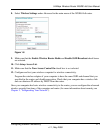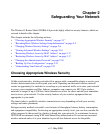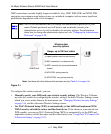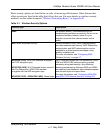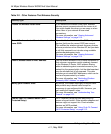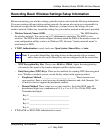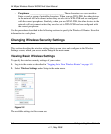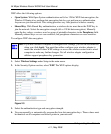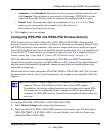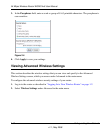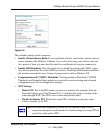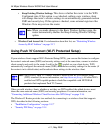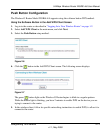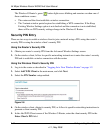
54 Mbps Wireless Router WGR614v8 User Manual
Safeguarding Your Network 2-7
v1.1, May 2008
• Name (SSID). The SSID is also known as the wireless network name. Enter a value of up to
32 alphanumeric characters. When more than one wireless network is active, different wireless
network names provide a way to separate the traffic. For a wireless device to participate in a
particular wireless network, it must be configured with the SSID for that network. The
WGR614v8 default SSID is NETGEAR. You can disable this broadcast as described in
“Viewing Advanced Wireless Settings” on page 2-10.
• Region. This field identifies the region where the Wireless-G Router can be used. It might not
be legal to operate the wireless features of the wireless router in a region other than one of
those identified in this field.
• Channel. This field determines which operating frequency is used. It should not be necessary
to change the wireless channel unless you notice interference problems with another nearby
wireless network. The wireless router uses channel bonding technology to extend the
bandwidth for data transmission. For more information about the wireless channel
frequencies, see the online document that you can access from “Wireless Networking Basics”
in Appendix B.
• Mode. This field determines which data communications protocol is used. You can choose
from: b and g; or g only.
• Security Options. The selection of wireless security options can significantly affect your
network performance. The time it takes to establish a wireless connection can vary depending
on both your security settings and router placement.
WEP connections can take slightly longer to establish. Also, WEP, WPA-PSK, and WPA2-
PSK encryption can consume more battery power on a notebook computer, and can cause
significant performance degradation with a slow computer. Instructions for configuring the
security options can be found in “Choosing Appropriate Wireless Security” on page 2-1. A full
explanation of wireless security standards is available in the online document that you can
access from “Wireless Networking Basics” in Appendix B.
3. Click Apply to save your settings.
Configuring WEP Wireless Security
WEP Shared Key authentication and WEP data encryption can be defeated by a determined
eavesdropper using publicly available tools.
Note: The region selection feature might not be available in all countries.



